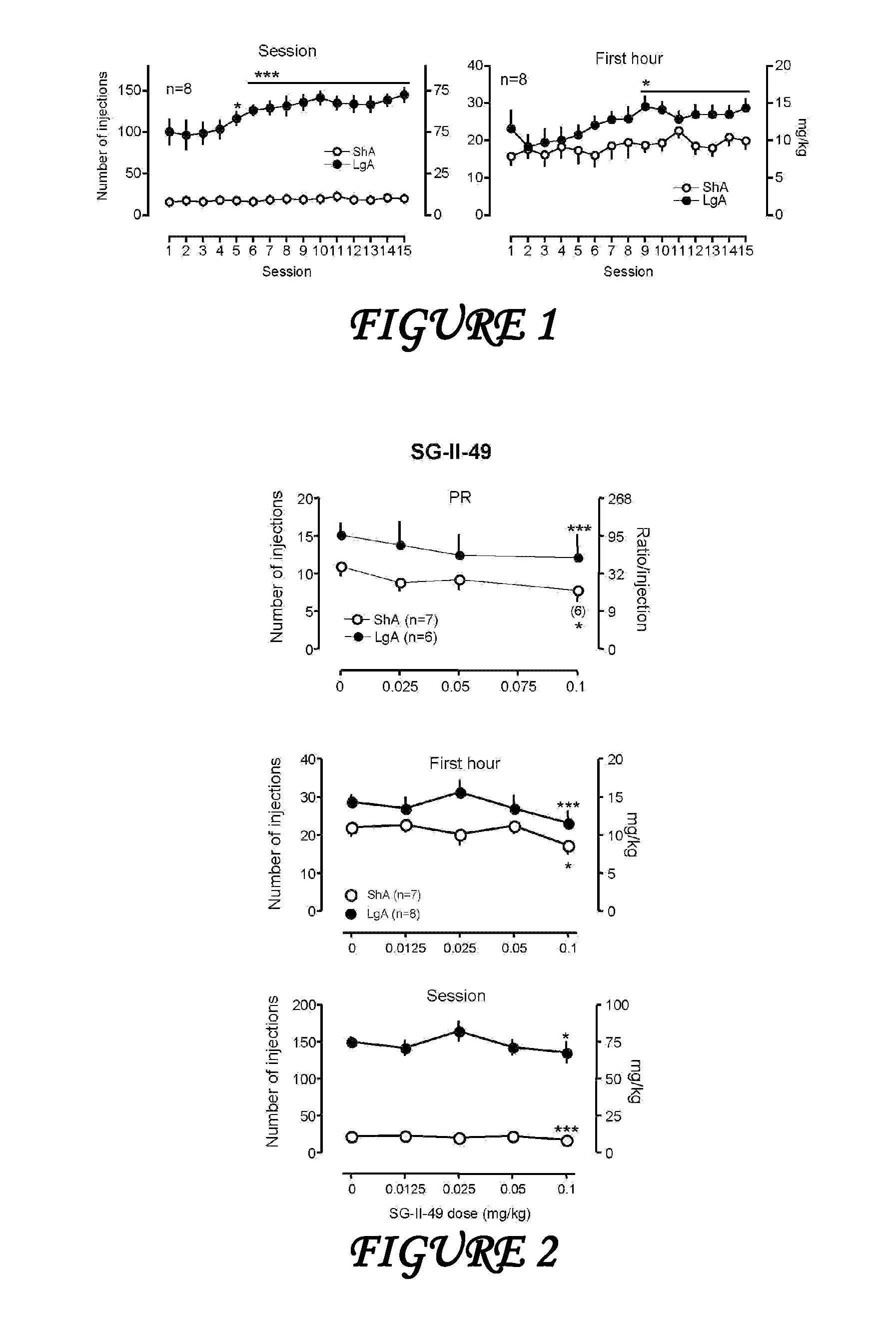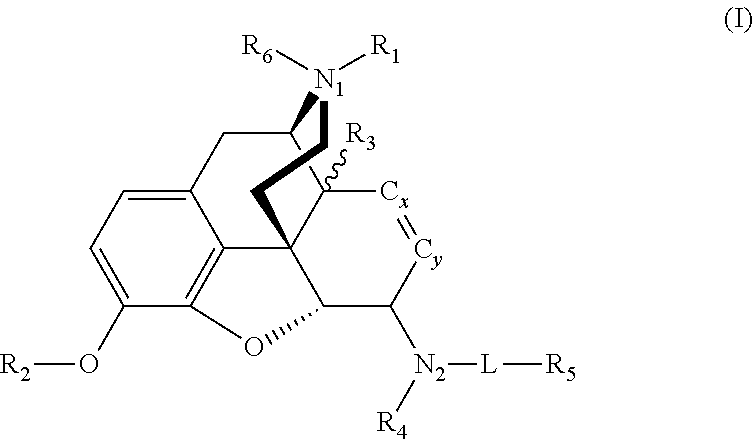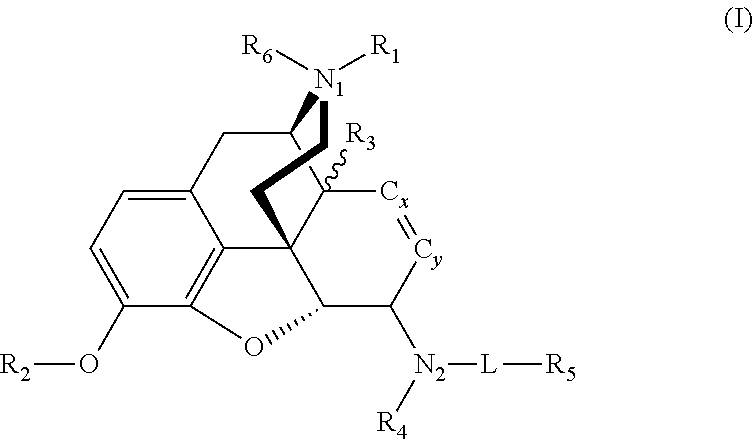Synthesis of metabolically stable agents for alcohol and drug abuse
a technology of metabolic stability and alcohol, applied in the field of pharmaceutical agents, can solve the problems of confusion in the treatment of patients with liver disease, the inability of naltrexone to treat all alcoholics, and the dependence on alcohol, tobacco and illicit drug abuse, etc., and achieve the effect of reducing alcohol consumption and cocaine consumption
- Summary
- Abstract
- Description
- Claims
- Application Information
AI Technical Summary
Benefits of technology
Problems solved by technology
Method used
Image
Examples
example 1
Naltrexone Oxime (2)
[0272]Naltrexone 1 (500 mg, 1.46 mmol), NH2OH—HCl (147 mg) and NaOAc (294 mg) were dissolved in absolute ethanol (8 mL) and the mixture was heated at reflux for 2.5 h and then concentrated to dryness. Water (20 mL) was added and the mixture was made basic with K2CO3 and extracted with CHCl3. The CHCl3 extract was washed with brine, dried over Na2SO4, filtered and concentrated to give a white solid (463 mg, 89%): ESI-MS m / z 357 (MH+). 1H NMR (CDCl3) δ 6.75 (d, J=8.2 Hz, 1H), 6.61 (d, J=8.2 Hz, 1H), 5.0 (s, 1H), 3.15 (m, 2H), 2.65-1.3 (m, 10H), 0.86 (m, 1H), 0.56 (m, 2H), 0.2 (m, 2H).
example 2
6-α-Naltrexamine (3a). and 6-β-naltrexamine (3b)
[0273]Naltrexone oxime (5.83 g, 16.3 mmol) was dissolved in THF (40 mL) and transferred by cannula over 10 min to a solution of BH3:THF (300 mL, 300 mmol, 1 M solution in THF) held at 10° C. A white precipitate formed and then slowly dissolved as the reaction was heated at reflux for 48 h. The solution was cooled to room temperature and water (10 mL) and 1 N KOH (200 mL) was added slowly. The solution was then reheated at reflux for 2 h. The pH was reduced to 2.5 with 10% HCl (225 mL) and the solution was heated at reflux for additional 2 h. The THF was removed under vacuum and the aqueous solution was made basic (pH 8-9) with K2CO3. The mixture was extracted with CHCl3 (4×150 mL) and the extract was dried over Na2SO4, filtered and concentrated. The resulting oil was purified by chromatography on SiO2 (26×60 cm, elution with CH3CN / MeOH / NH4OH, 25:5:1, v:v) providing 3b (beta diastereomer) (2.14 g, 38%) as a white-yellow solid: Rf=0.2; 1...
example 3
6-α-N-Methylnaltrexamine (3c) and 6-β-N-Methylnaltrexamine (3d)
[0274]Synthesis of 6-α-N-methylnaltrexamine (3c) and 6-β-N-methylnaltrexamine (3d) was done as follows: To a mixture of naltrexone (100 mg, 0.29 mmol) and methylamine (2.0 M solution in methanol, 1.5 mL, 2.9 mmol) was added methanolic solution of NaCNBH3 (12 mg, 0.18 mmol). The pH was adjusted to 7 with concentrated HCl. The mixture was then stirred at room temperature for 3 days. The solution was acidified to pH 1 with concentrated HCl and the solvent was removed in vacuo. The resultant residue was dissolved in water and extracted with chloroform to remove water insoluble material. The pH of the aqueous solution was adjusted to 9 with sodium carbonate, extracted with chloroform, dried over Na2SO4, filtered and chloroform was removed in vacuo. The resultant crude product was purified by flash chromatography (EtOAc / MeOH / NH4OH, 10:8:0.3, v:v) to give the a diastereomer, 3c (36.9 mg) and the β diastereomer, 3d (35.2 mg) as ...
PUM
| Property | Measurement | Unit |
|---|---|---|
| Molar density | aaaaa | aaaaa |
| Molar density | aaaaa | aaaaa |
| Molar density | aaaaa | aaaaa |
Abstract
Description
Claims
Application Information
 Login to View More
Login to View More - R&D
- Intellectual Property
- Life Sciences
- Materials
- Tech Scout
- Unparalleled Data Quality
- Higher Quality Content
- 60% Fewer Hallucinations
Browse by: Latest US Patents, China's latest patents, Technical Efficacy Thesaurus, Application Domain, Technology Topic, Popular Technical Reports.
© 2025 PatSnap. All rights reserved.Legal|Privacy policy|Modern Slavery Act Transparency Statement|Sitemap|About US| Contact US: help@patsnap.com



